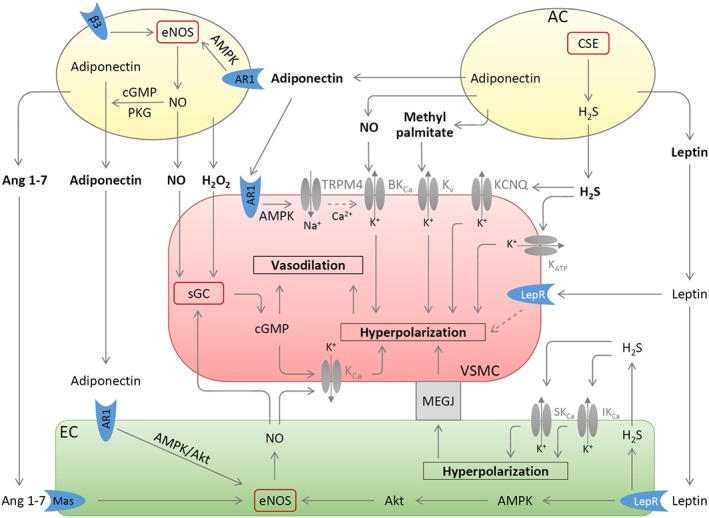Figure 1.

PVAT‐derived vasoactive molecules. Methyl palmitate produced by PVAT adipocytes (AC) causes vasodilatation by opening the Kv channels on VSMC. H2S is synthesized in PVAT by CSE and induces VSMC hyperpolarization by stimulating KCNQ‐type Kv or KATP channels. Leptin induces endothelium‐dependent vasodilatation by stimulating leptin receptor (LepR), which leads to activation of eNOS via a pathway involving AMPK and Akt and to H2S production. This H2S functions as an EDHF and activates endothelial small (SKCa) and intermediate (IKCa) conductance calcium‐dependent K+ channels via autocrine mechanisms. The resulting hyperpolarization of endothelial cells can be transmitted to VSMC by electrical coupling through myoendothelial gap junction (MEGJ). Leptin also causes endothelium‐independent vasodilatation by inducing VSMC hyperpolarization through unknown mechanisms. NO and H2O2 released from PVAT can elicit vasodilatation by activating sGC leading to the synthesis of cGMP. Adiponectin released from PVAT AC can be enhanced by stimulation of β3 adrenoceptors (β3) and by the NO‐cGMP‐PKG pathway. Adiponectin exerts multiple vascular effects: it stimulates NO production from PVAT and from endothelial cells and induces VSMC hyperpolarization by activating TRPM4 channels followed by opening BKCa; Ang 1–7 produced by PVAT acts on endothelial Ang 1–7 receptor (Mas; MAS1 receptor) thereby stimulating endothelial NO production. Besides stimulating sGC activity, NO from PVAT and endothelial cells can also induce/potentiate VSMC hyperpolarization through KCa or BKCa. Partly adopted from (Beltowski, 2013; Weston et al., 2013; Withers et al., 2014a).
